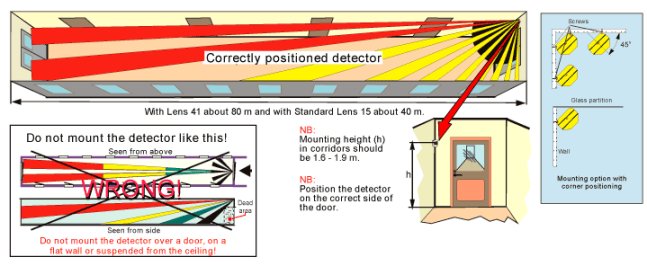2G. Corridor with passive IR detector
Dimmable HF ballasts, soft start and multi-level “Dynamic Lighting control”
| Premises
This application shows a hotel corridor with doors on one side and windows that allow plenty of natural light to enter on the other side. It is used very frequently during certain times of the day, when people pass through often. A dynamic daylight-regulated lighting system is therefore installed. Light source The light fittings in this application have dimmable HF ballasts with 1 – 10 V control. Placement of detectors and lens choice To achieve optimum detection and a high level of comfort it is important for detectors to be mounted in the correct position. This is particularly important with corridor solutions. Unfortunately one far too often sees detectors aimed at doors and entrances, thus adversely affecting detection. The optimum detection direction is obtained when people pass across the detection field at 90°, and the worst detection accuracy is obtained when people walk towards or away from the detection field. For this reason the detector should be fitted with a lens that provides a 90° detection angle. It should be installed in a corner next to the door that most people pass through, so that it is not obscured when the door is opened. The correct installation height is 1.6–1.9 m in corridors. In corridors up to 40 m long a number 15 standard lens is suitable. Long corridors require a lens that combines a long field of view and a 90° angle of view, such as lens 41. In long corridors that have an entrance door at the far end, detection may be poor when people enter through this door. This is because there is little movement across the field of view. There are around 40 other lenses to choose from. See the lens archive in the handbook. Control system With new buildings or renovations, when there is a possibility of selecting fittings with dimmable operating devices, installation should be in accordance with the principle of ‘Dynamic Lighting Control’. The technology can be used for control using both acoustic and IR detectors. See wiring diagram below. With the NV-4T, dimmable fluorescent-tube fittings can provide control on four light levels. |
The most important advantages attained using Dynamic Control are as follows:
During the day, when there is sufficient natural light, the light sensor in the PD-2200 prevents the lighting from being switched on at all. It is adjusted to the desired level so that the lighting is switched on when presence is detected. After dusk the system switches to the nighttime programme and the lighting is switched to around 30 per cent of the level used when presence is detected. When presence is no longer detected at night the lighting is first reduced to around one per cent base lighting, and after around 1–2 hours the lighting is switched off entirely to eliminate idle losses. When switching from a low level to a higher level the lighting is always ramped up gradually by the SD-1 soft dim module. The ramp-up rate can be adjusted by means of a potentiometer. The ramp-down rate cannot be adjusted. See the graph on the right. The energy saving is around 20 per cent during daytime operation and around 70 per cent during the evening and at night when the lighting is switched on. |
||||||||||||||||||||||
 |
|||||||||||||||||||||||
 |
|||||||||||||||||||||||
|
Installation of the detectors should be using the simplest possible cable, Type EKKX 1 x 4 x 0.25 mm2. All detectors should be connected in parallel with the rectifier EXE-2000, even if they form part of different areas. Regarding adjustment of the IR detectors one is referred to the manual enclosed with the detector. |
|||||||||||||||||||||||
 |
|||||||||||||||||||||||
|
|
||||||||||||||||||||||
| Daylight-dependent lighting control with NV-4T in corridor | |||||||||||||||||||||||
 |
|||||||||||||||||||||||






